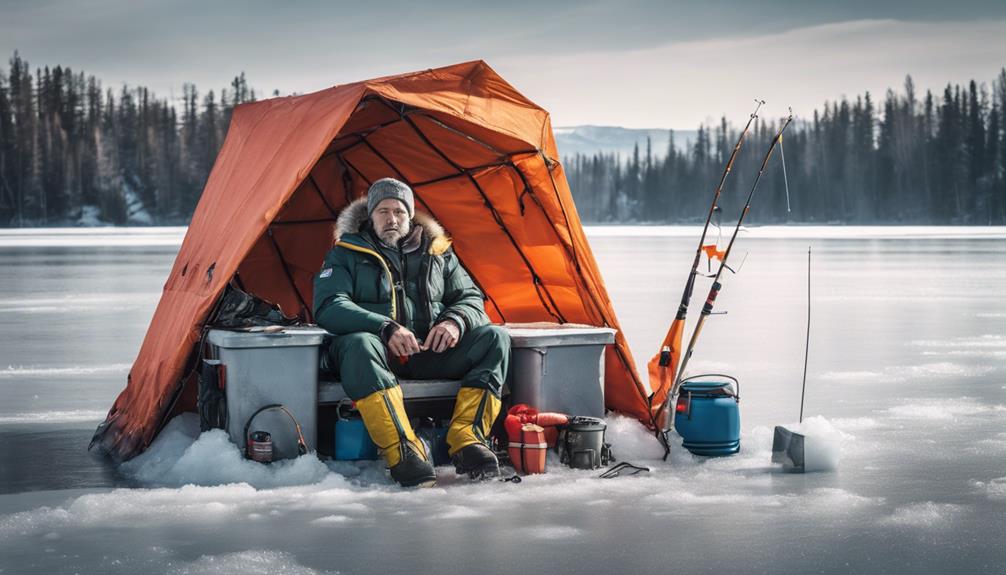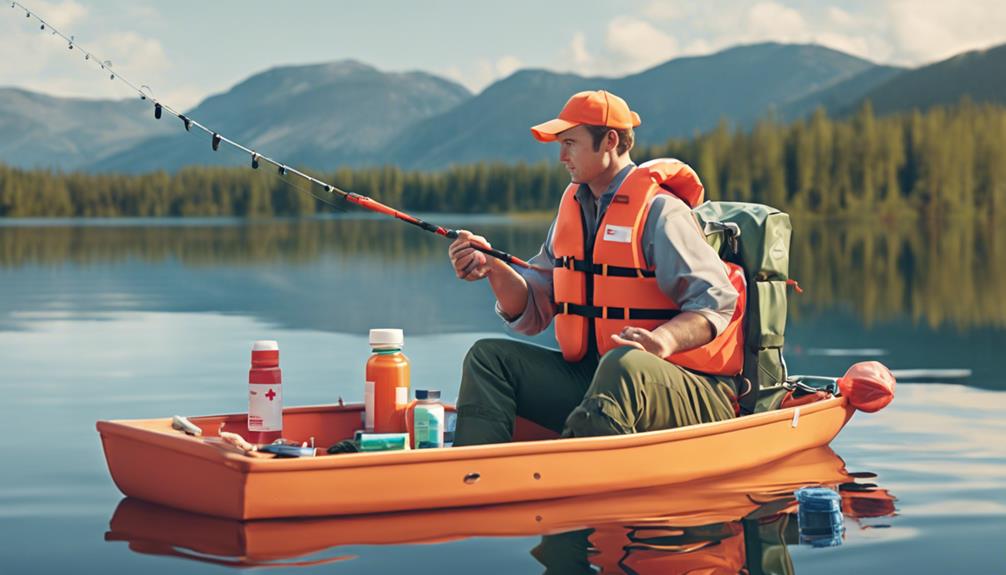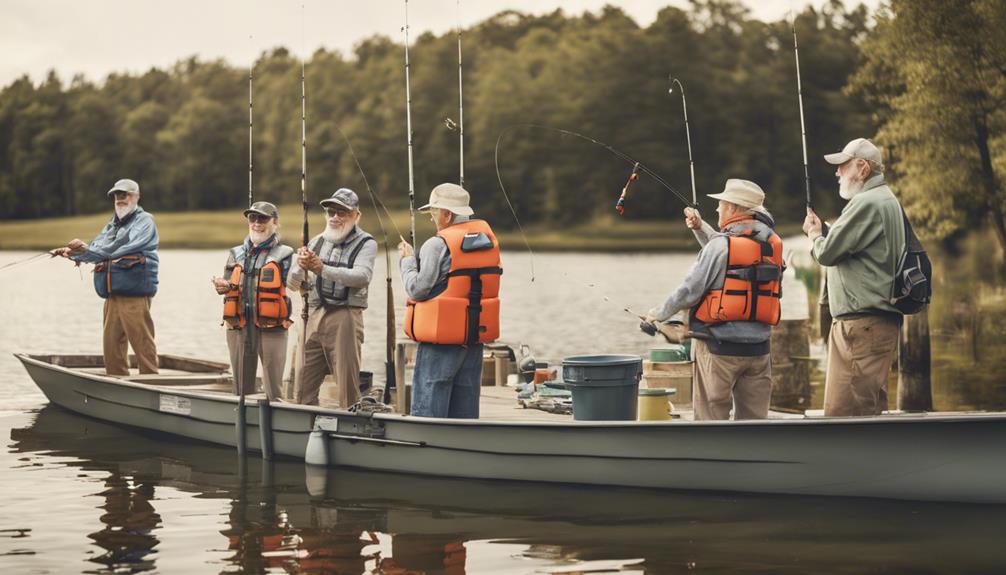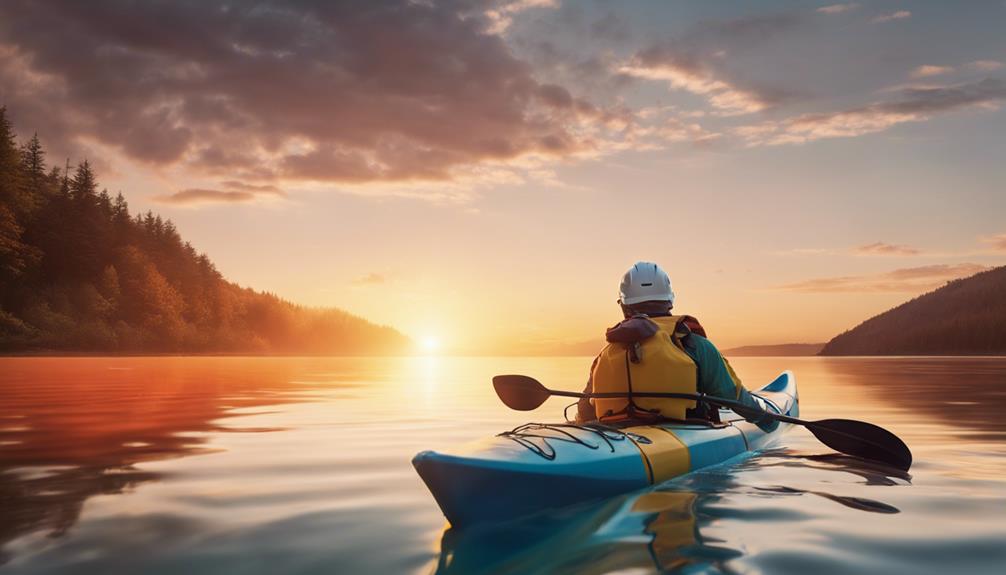When it comes to ice fishing, the serene beauty of a frozen lake can quickly turn into a hazardous environment if not approached with caution. From selecting the right gear to practicing responsible fishing methods, these 9 best practices are crucial for ensuring your safety on the ice.
But what if a sudden weather change puts you at risk? Stay tuned to discover how having a solid emergency action plan can make all the difference in such situations.
Proper Gear Selection
When ice fishing, ensure you have selected the appropriate gear for the conditions and your safety. Proper gear selection is crucial for a successful and safe ice fishing experience. Start by checking your gear maintenance to ensure everything is in good working condition. Inspect your ice auger, fishing rods, reels, and shelters for any signs of damage or wear and tear. It's essential to address any maintenance issues before heading out onto the ice to prevent any mishaps.
Next, pay close attention to equipment sizing. Your ice fishing gear should be suitable for the conditions you'll be facing. Make sure your ice auger is the right size for the thickness of the ice you'll be drilling into. Similarly, your fishing rods should be appropriate for the type of fish you're targeting and the depth at which they swim. Ill-fitting gear can't only impede your fishing success but also pose a safety risk on the ice.
Before setting out, double-check that all your gear is properly sized and maintained. Taking the time to ensure your equipment is in top condition won't only improve your chances of a successful catch but also help keep you safe while ice fishing. So, gear up correctly, stay vigilant, and enjoy a rewarding ice fishing adventure!
Ice Thickness Awareness
Ensure that you're aware of the ice thickness before venturing out for your ice fishing expedition. Ice safety is paramount when engaging in this activity, and knowing the thickness of the ice you'll be walking and fishing on is crucial for your well-being. Before stepping onto the ice, always measure its thickness to ensure it's safe for your activity.
To assess ice thickness, utilize a reliable ice chisel, auger, or ice spud. These tools can help you drill through the ice to measure its thickness accurately. Ideally, the ice should be at least 4 inches thick for safe ice fishing. However, this measurement may vary depending on the region and conditions, so it's essential to check with local authorities or experienced anglers for guidance on safe ice thickness in your area.
Remember that clear ice is generally stronger than cloudy or white ice. Clear blue ice is the safest because it's the most dense. Be cautious around ice that has formed over flowing water, near docks, or where the ice appears slushy. These areas may have thinner ice due to varying factors affecting its formation.
Buddy System Implementation
Implementing the buddy system enhances safety during ice fishing expeditions. When venturing out onto the ice, having a buddy by your side can make a significant difference in mitigating risks and responding effectively to emergencies.
Here are some key points to consider when implementing the buddy system:
- Safety Precautions: Share safety protocols with your buddy before setting out on the ice. Make sure both of you're aware of the potential hazards and how to address them. Discuss the importance of staying within sight of each other and establishing designated meeting points in case of separation.
- Communication Strategies: Establish clear communication methods with your buddy. Carry two-way radios or ensure that your cell phones have service on the ice. Agree on signals or calls that indicate danger or the need for assistance. Regularly check in with each other to ensure everyone is safe.
- Teamwork and Support: Work together as a team to enhance safety. Keep an eye out for each other and be ready to assist in case of slips, falls, or emergencies. By having a buddy system in place, you not only increase safety but also have someone to rely on in challenging situations.
First Aid Kit Preparation
Prepare your first aid kit before heading out for an ice fishing trip to ensure you're equipped to handle any emergencies that may arise. Stock your kit with essential items such as bandages, antiseptic wipes, gauze pads, adhesive tape, scissors, tweezers, pain relievers, cold packs, and any personal medications you may need. It's crucial to have these first aid essentials readily available in case of injuries while out on the ice.
Familiarize yourself with basic emergency procedures before your trip. Knowing how to properly clean and dress wounds, stabilize fractures, and handle hypothermia or frostbite can make a significant difference in an emergency situation. Quick and appropriate first aid can prevent minor injuries from becoming major issues.
Additionally, consider taking a first aid and CPR course to enhance your emergency response skills. Being prepared and knowledgeable can help you stay calm and act effectively during stressful situations. Remember, in emergencies, every second counts.
Regularly check and restock your first aid kit to ensure that all supplies are up to date and in good condition. Having a well-prepared kit can provide peace of mind and potentially save lives in critical situations. Prioritizing first aid preparation is a responsible and essential part of safe ice fishing practices.
Weather Monitoring Practices
Monitoring the weather conditions is crucial for safe ice fishing trips. Being aware of temperature changes and potential storms can help you make informed decisions to keep yourself and others safe on the ice. Here are some key practices to follow:
- Temperature tracking: Keep an eye on the forecasted temperatures to ensure the ice remains thick and safe for fishing. Sudden rises or drops in temperature can weaken the ice, making it dangerous to venture out.
- Storm monitoring: Stay updated on weather reports for any incoming storms or extreme weather conditions. It's essential to know if a storm is approaching so you can safely make your way back to shore before it hits.
- Weather alerts, safety precautions: Sign up for weather alerts and pay attention to any warnings or advisories issued for your area. Always have a plan in place for emergencies and make sure to carry safety gear such as ice picks, a floatation device, and a fully charged cell phone in case of any unforeseen circumstances.
Equipment Maintenance Tips
To ensure your equipment is in optimal condition for your ice fishing expedition, regular maintenance checks are essential. Regular inspection of your ice fishing gear is crucial to identify any wear and tear that may have occurred.
Start by examining your ice auger for any signs of damage or rust. Make sure the blades are sharp and in good working condition. Check the integrity of your ice fishing rods and reels by inspecting the guides, reel seat, and drag system. Replace any worn-out components and lubricate the moving parts to prevent malfunctions while out on the ice.
Timely repairs are key to preventing equipment failures during your ice fishing trip. If you notice any issues during your inspection, address them promptly. Repair or replace damaged parts such as frayed fishing lines, broken rod tips, or malfunctioning reel mechanisms.
Keep a small repair kit handy that includes essentials like extra line, hooks, and tools for quick fixes on the go. By staying proactive and fixing problems as they arise, you can ensure that your equipment performs optimally and enhances your ice fishing experience. Remember, a well-maintained gear set can make all the difference between a successful outing and a frustrating one.
Emergency Action Planning

In the event of an emergency while ice fishing, swift and decisive action can be the difference between a manageable situation and a potentially dangerous one. It's crucial to have an emergency action plan in place before heading out onto the ice. Here are some key steps to consider:
- Designate an Emergency Contact: Always inform someone reliable about your ice fishing plans. Share details of your location, expected return time, and any other relevant information. In case of an emergency, this person can contact authorities for help.
- Identify Evacuation Routes: Before setting up your fishing spot, familiarize yourself with the surroundings and locate the nearest evacuation routes. This could include paths back to shore, access points for emergency vehicles, or areas where rescue teams can easily reach you.
- Emergency Equipment: Carry essential emergency equipment such as a first aid kit, ice picks, a throw rope, and a charged cell phone in a waterproof bag. These items can prove invaluable in various emergency scenarios.
Responsible Fishing Practices
Practice responsible fishing by always following local regulations and respecting the environment and wildlife around you. When ice fishing, it's crucial to adopt eco-friendly techniques to minimize your impact on the delicate ecosystem. One way to achieve this is by using biodegradable fishing line and non-toxic bait to prevent harm to aquatic life. Additionally, consider practicing catch and release to conserve fish populations and ensure sustainability for future generations.
Ethical harvesting practices are essential for responsible fishing. Only keep what you plan to consume, and release any fish that don't meet legal size limits. Avoid wasteful practices by properly disposing of any trash or fishing gear, as litter can harm wildlife and pollute the environment. When drilling ice holes, make sure to clean up any ice shavings to prevent contamination of the water.
Respecting the environment goes hand in hand with responsible fishing. Be mindful of your surroundings and avoid disturbing wildlife habitats. Stay on designated paths and avoid trampling vegetation to preserve the natural landscape. By practicing these responsible fishing techniques, you can enjoy the sport while protecting the environment for future anglers to enjoy.
Frequently Asked Questions
Can You Ice Fish Alone or Is It Always Necessary to Have a Buddy System in Place?
When ice fishing solo, you should take precautions to ensure your safety. It's always a good idea to have emergency communication strategies in place.
Make sure someone knows your plans and expected return time. Carry a fully charged phone, a whistle, and a rope for emergencies. Stay alert and aware of changing ice conditions. Being prepared can help make solo ice fishing a safer and enjoyable experience.
How Should Ice Fishing Gear Be Properly Stored During the Off-Season?
When the ice fishing season ends, you must store your gear properly to keep it in good shape for next year. Proper maintenance is key to ensure your equipment lasts.
Clean and dry your gear thoroughly before storing it away. Seasonal storage helps prevent rust and damage. Keep your rods, reels, lines, and other equipment in a cool, dry place to maintain their quality.
Take care of your gear, and it will take care of you during the next ice fishing season.
What Should Be Included in a Basic First Aid Kit for Ice Fishing Emergencies?
When heading out for ice fishing, it's crucial to have a well-equipped first aid kit. Make sure your kit includes essentials like bandages, gauze, antiseptic wipes, adhesive tape, and pain relievers.
Being prepared for emergencies can make all the difference in your response to injuries while out on the ice. Stay safe by keeping your first aid kit stocked and easily accessible for any unexpected situations that may arise during your fishing excursion.
Are There Any Specific Weather Conditions That Should Signal an Immediate Evacuation From the Ice?
If faced with extreme conditions while ice fishing, it's crucial to know evacuation signals and emergency protocols. Certain weather conditions like sudden temperature changes, cracking ice, or heavy snow can signal immediate danger.
Prioritize safety precautions and be aware of any warnings or advisories issued by authorities. Always err on the side of caution when it comes to your well-being on the ice.
How Often Should Ice Fishing Equipment Be Inspected and Maintained for Safety?
You should frequently inspect and maintain your ice fishing equipment for safety. Check your gear before every outing to ensure everything is in good condition.
Safety precautions like examining your ice shelter, auger, heaters, and ice picks can help prevent accidents on the ice.
Don't forget to regularly inspect and maintain your gear to enjoy a safe and successful ice fishing experience.
Conclusion
Remember, safety should always be your top priority when ice fishing. By following these best practices, you can ensure a fun and enjoyable experience on the ice while minimizing risks.
Always be prepared with the right gear, stay aware of ice thickness, and never go out alone. With proper planning and precautions, you can have a successful ice fishing trip every time.
Stay safe and happy fishing!



